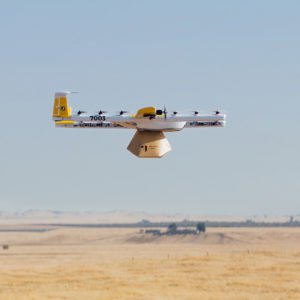At Amsterdam Drone Week yesterday, James Burgess of Google X spinoff Wing shows off a system of drone delivery that’s made over 2500 customer flights in a test outside of Canberra, Australia.
In the last nine months, Wing – graduated from Project X and now independent under parent company Alphabet – has worked on a widespread test of drone delivery in a suburban community of Australia.
The Wing test is both broad and deep. Wing isn’t just testing the safety and utility of their delivery drone and logistics process, but the viability of their UTM platform, which they hope to make available to 3rd parties. They’re working through usability issues for their delivery customers, their neighbors, and regulators – and while Burgess acknowledges that there are still many issues to consider, Wing has gone a long way in addressing the needs of the entire stakeholder community in drone delivery.
Drone Delivery, On Demand
Wing’s customer is the consumer. Customers in the test area can request drone delivery from a number of different local businesses: first they order an item from a business, like a package of children’s aspirin from a local pharmacy. Wing then dispatches a drone – empty – from a launch area, and travels to the airspace around the pharmacy, without landing. The drone lowers a winch, and the pharmacy attaches the package of aspirin. Wing then flies to the customers home – or the nearest viable and safe delivery point, which the customer may choose from – and lowers the package to them, again without landing: which means that customers and businesses only interact with the package, not the drone.
It’s a service that has proved more popular than Wing imagined. Customers have used the service more than anticipated, with over 2500 customer flights completed. Having already moved from more rural areas into the suburbs, next year Wing plans to move the service to more populated urban areas.
The UTM Solution
In any drone delivery implementation, safety is paramount. Wing’s drone is built with multiple redundancies – the 12 rotor drone is designed to meet and exceed safety standards. But when it comes to ensuring that delivery drones do not interfere with manned aircraft, Wing’s UTM system is demonstrating how drones can interact safely in shared airspace. “We think unmanned systems should always yield to unmanned systems,” says Burgess. “That’s a design principle.”
In a stunning visualization of the system, Wing shows how the UTM system creates virtual flight corridors which it reserves for drone flights. It’s an incredibly sophisticated system: taking into consideration weather, wind, and numerous other airspace issues.
Wing hopes that their UTM system will be available to third parties: they are committed to making a basic UTM platform available to drone pilots for free. That Basic UTM system would include: information on fly/no fly zones, rules and compliance, airspace access and approvals, remote identification, and deconfliction.
Privacy and the Public
With recognition that not everyone will use – or be happy to see – drones delivering in their neighborhood, Wing is addressing issues of privacy, transparency, and noise as they test the reaction of neighbors to their service. “We believe that transparency is the key,” says Burgess. “What’s the right level of transparency? There’s a balance.” Wing provides a public app that allows people to see what drones may be flying over their street at a particular time.
The company is also working on ways to mitigate concerns over noise – including development work to change the pitch of drone noise, or consider routes over areas with more ambient noise so that the drone sounds will blend into the environment.
While widescale adoption of drone delivery is still a long way off in the U.S., the Wing project is examining all aspects of the problem – and providing benefit to their delivery customers right now.
Miriam McNabb is the Editor-in-Chief of DRONELIFE and CEO of JobForDrones, a professional drone services marketplace, and a fascinated observer of the emerging drone industry and the regulatory environment for drones. Miriam has a degree from the University of Chicago and over 20 years of experience in high tech sales and marketing for new technologies.
Email Miriam
TWITTER:@spaldingbarker
Subscribe to DroneLife here.
https://dronelife.com/2018/11/30/wing-google-spinoff-combines-utm-and-drone-delivery-for-maximum-benefit-in-australia/
 Unmanned Aerial Vehicle The latest drone news
Unmanned Aerial Vehicle The latest drone news





